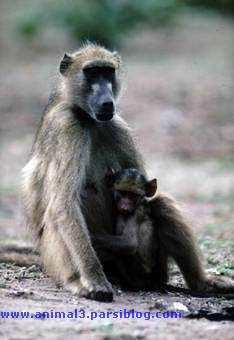بازدید امروز :7
بازدید دیروز :175
کل بازدید :392228
تعداد کل یاداشته ها : 1567
04/4/26
12:45 ص
Baboon
The chacma baboon of southern Africa is one of at least three races of the savanna baboon. A forest-floor dweller, the chacma baboon is omnivorous, feeding on seeds, fruits, grasses, cultivated crops, insects, and small, young mammals. The call of another species, the olive baboon, can be heard here.
Baboon, common name applied to certain large African monkeys and sometimes to the closely related gelada. Most baboons are adapted to life on the ground and avoid forests; they range in large herds, called troops, over rocky, open lands and wooded areas of Africa and the Arabian Peninsula.
Baboons are powerful and aggressive animals about the size of a large dog. They have strong, elongated jaws, large cheek pouches in which they store food, and closely spaced eyes. They have pronounced brow ridges and strong limbs. Baboons can distinguish colours and have a keen sense of smell. They have large, often brightly coloured, hairless areas on their buttocks, and thick, sturdy legs. The tail of the mandrill and drill is generally short and is carried high in an arch.
Baboons eat various worms, eggs, insects, reptiles, crabs, molluscs, small mammals, fruits,flamingo, and young shoots. Baboon troops usually number from 30 to more than 100 members. Baboons have several different calls, many of which have specific meanings. After a gestation period of about six months, a female usually bears a single offspring, which clings to its mother"s underside. Rarely a female has twins.
The largest of the baboons is the chacma (a kind of mandrill) of southern Africa. Known also as the pig-tailed baboon, it is greyish-brown with a green tint along the back. The adult male may weigh up to 41 kg (90 lb) and is a formidable fighter against the troop"s enemies.
The olive baboon is found in the sub-Saharan savannah region extending from Mali to Ethiopia and northern Tanzania, and is also found in several mountainous regions of the Sahara desert. It has a darker brown coat than that of the chacma.
The yellow baboon is native to western, central, and eastern Africa, south to Mashonaland in Zimbabwe. The several subspecies of these baboons all have light yellow coats and blackish faces.
Another well-known species is the North African hamadryas baboon of northern Africa and the south-western Arabian Peninsula. It is known as the “sacred baboon” because it was deified by the ancient Egyptians. It has a pink face and a long snout, and males have a long mane covering the neck and shoulders.
The mandrill, a large baboon of western Africa, has an enormous head, crested and bearded, and almost no forehead. Another western African species is the drill, somewhat smaller than the mandrill, but similar in its lack of aggressive behaviour. The gelada, the only true primate grazer, spends the night sleeping in the cliffs of gorges in central Ethiopia.
Scientific classification: Baboons belong to the family Cercopithecidae. The chacma is classified as Papio ursinus, the olive baboon as Papio anubis, the yellow baboon as Papio cynocephalus, the hamadryas baboon as Papio hamadryas, the mandrill as Papio sphinx, the drill as Papio leucophaeus, and the gelada as Theropithecus gelada. In some classification systems the
mandrill and drill are not classified as baboons but are placed in a closely related genus, Mandrillus.


